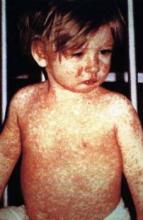As of May 23, 288 measles cases were reported to the Centers for Disease Control and Prevention, the highest number reported by that date in the United States since 1994.
The cases have been reported in people aged from 2 weeks to 65 years, most (69%) in unvaccinated patients or those whose vaccination status is not known (20%). Nearly all cases (97%) have been associated with importation from at least 18 countries, particularly the Philippines, which is in the midst of a large outbreak that began in October 2013.
To date, there have been no deaths or cases of encephalitis, but 43 people (15%) have been hospitalized. Complications have included five cases of pneumonia, one case of hepatitis, one case of pancytopenia, and one case of thrombocytopenia.
In 1994, a total of 764 cases had been reported in the United States by May 23.
The large and growing number of cases reported this year "is a wake up call for parents and clinicians," Dr. Anne Schuchat, director of the CDC’s National Center for Immunization and Respiratory Diseases, said during a press briefing May 29. "If you’re a parent or clinician, remember that measles may be forgotten but it isn’t gone," she added.
The large number of reports "emphasizes the need for health care providers to have a heightened awareness of the potential for measles in their communities and the importance of vaccination to prevent measles," according to the CDC report (MMWR 2014; 63:1-4).
Dr. Schuchat advised health care providers to review a patient’s vaccination history before they travel and to not take for granted that adult patients are vaccinated. "As people are caring for middle-aged and younger adults, they shouldn’t take for granted that they got all the recommended vaccines when they were a child," she said. If a patient’s records are not available, or patients do not know if they have been vaccinated, a dose of the measles, mumps, and rubella (MMR) vaccine can be administered, as recommended by the CDC in this situation, she pointed out.
More than half the cases (151) reported through May 23 have been in people aged 20 years and older.
The mean size of the reported outbreaks is 5 cases, with a range of 3-138 cases. The outbreak of 138 cases is in Ohio, affecting mostly unvaccinated people in Amish communities, and is ongoing, Dr. Schuchat said. This outbreak has been linked to importation from the Philippines, she said, noting that individuals in Ohio traveled to that country to do service work.
Of the 195 U.S. residents with measles who were not vaccinated, 85% were not vaccinated for religious, philosophical, or personal reasons, not because of their age or a medical reason, according to the CDC report.
Other details of the 288 cases include:
• This year, measles cases have been reported in New York City and in 18 states, including multiple communities in California.
• Eighteen cases (6%) have been in children under age 12 months (who are too young for routine vaccination), 48 (17%) were aged 1-4 years, and 71 (25%) were aged 5-19 years.
• A total of 45 cases were directly imported to the United States – 40 in U.S. residents traveling abroad and 5 in residents of other countries visiting the United States; 22 of those cases were from the Philippines.
• From Jan. 1 through April 20, 2014, over 32,000 measles cases and 41 measles-related deaths have been reported in the Philippines.
Measles was considered eliminated in the United States in 2000, which means there was no spread within the country for more than 12 months. But Dr. Schuchat described this as "a very fragile state," pointing out that indigenous spread occurs if the chains of transmission cannot be broken, referring to an outbreak of over 20,000 cases in France a few years ago.
Two doses of MMR vaccine are recommended, one at age 12-15 months and the second between 4 and 6 years. The CDC recommends a dose for infants as young as 6 months traveling internationally (who will still need to receive two doses later if they receive one dose between 6 and 11 months).


